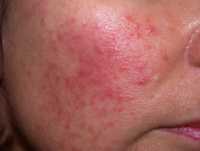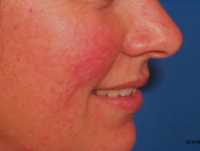
09 Jul Dermatologist Discusses Patient Struggles with Facial Rosacea and Psoriasis
MedicalResearch.com Interview with:

Dr. Harper
Julie C. Harper, MD
Clinical Associate Professor of Dermatology
University of Alabama-Birmingham
MedicalResearch.com: What is the background for this study?
How common is rosacea?
What are the clinical manifestations of facial rosacea or psoriasis?
-
- In 2018, the initial Beyond the Visible report provided new insights into rosacea and the psychosocial burden associated with invisible symptoms. These insights further highlighted how little is really known of the burden faced by those suffering from facial skin diseases. In this new 2020 report, Beyond the Visible: rosacea and psoriasis of the face, we explored new dimensions of the burden faced by both rosacea and psoriasis of the face patients to learn from patients’ experiences and behaviors to better inform treatment based on the comparisons and contrasts. The survey spanned six countries, 300 rosacea patients and 318 psoriasis of the face patients to answer three questions:
- What is the burden faced by patients with psoriasis of the face and of rosacea?
- How does the burden faced by rosacea patients differ from patients with psoriasis of the face?
- What can we learn to help both patients and doctors to achieve the best possible outcomes for their patients?
- Rosacea is more common than people might initially assume. There are an estimated 16 million Americans with rosacea, building up to 415 million rosacea sufferers worldwide.
- Rosacea is commonly characterized by persistent redness and facial flushing, inflammatory lesions which may resemble acne-like bumps, visible blood vessels, and skin thickening. However, it’s important to note that rosacea symptoms vary person to person. Psoriasis of the face symptoms present themselves as red, scaly lesions that are usually along the forehead, hairline and ears. Moreover, psoriasis is known to be associated with itching, while rosacea sufferers have reported burning and stinging.
- In 2018, the initial Beyond the Visible report provided new insights into rosacea and the psychosocial burden associated with invisible symptoms. These insights further highlighted how little is really known of the burden faced by those suffering from facial skin diseases. In this new 2020 report, Beyond the Visible: rosacea and psoriasis of the face, we explored new dimensions of the burden faced by both rosacea and psoriasis of the face patients to learn from patients’ experiences and behaviors to better inform treatment based on the comparisons and contrasts. The survey spanned six countries, 300 rosacea patients and 318 psoriasis of the face patients to answer three questions:

Rosacea- DermNet NZ image Not For Self Diagnosis
MedicalResearch.com: What are the main findings? What are some of the available treatment or camouflage modalities?
-
- When comparing those suffering from rosacea with those suffering from psoriasis with facial involvement in this survey, we found both groups were remarkably similar in many aspects—including almost 90% of patients felt their disease was partially or totally uncontrolled and over 50% felt their disease significantly impacted their daily lives.
-
- Although people living with these skin conditions have similar psychosocial burdens, there are differences in the aspects of life investigated to determine quality of life for rosacea patients compared with psoriasis of the face patients. Doctors typically investigate the psychosocial burden less in new rosacea patients (9%) when compared to new psoriasis patients (22%). During these conversations, quality of life parameters more frequently assessed in psoriasis of the face patients than in rosacea patients included family life impact, impact on activities and sports, and days missed from work/school.
-
- There are a variety of available treatment options for rosacea including topical prescription treatments, low-dose antibiotics, even lifestyle modifications can have an impact.
- It is also important to teach rosacea patients to avoid those factors that may worsen or “trigger” their rosacea. These triggers can include sunlight, hot or spicy foods, red wine and stress.
MedicalResearch.com: What else should readers take away from your report?

Rosacea- DermNet NZ Image Not For Self Diagnosis
Response: It’s vital for healthcare providers to empower people with rosacea through knowledge about the condition, symptoms, and common psychosocial impacts. Rosacea patients are eager for more information with 73% of surveyed rosacea patients expressing a desire to know more about their disease. Moreover, educating patients during consultations about the likelihood of reaching ‘clear’ (IGA 0), may change their perception of rosacea treatment success. Open and honest doctor-patient dialogue is essential to improve treatment outcomes.
MedicalResearch.com: What recommendations do you have for future research as a result of this study?
Response: The psychological burden of rosacea is one of the primary reasons why people seek treatment. It is important that we continue to develop rosacea treatments that are effective at managing the physical signs of rosacea but that are also proven to lessen the psychosocial burden of the disease.
Any disclosures? Dr. Julie Harper is a paid Galderma consultant.
Citation:
BEYOND THE VISIBLE: ROSACEA & PSORIASIS OF THE FACE (2020)
dermskincare
[subscribe]
[last-modified]
The information on MedicalResearch.com is provided for educational purposes only, and is in no way intended to diagnose, cure, or treat any medical or other condition. Always seek the advice of your physician or other qualified health and ask your doctor any questions you may have regarding a medical condition. In addition to all other limitations and disclaimers in this agreement, service provider and its third party providers disclaim any liability or loss in connection with the content provided on this website.
Last Updated on July 9, 2020 by Marie Benz MD FAAD
